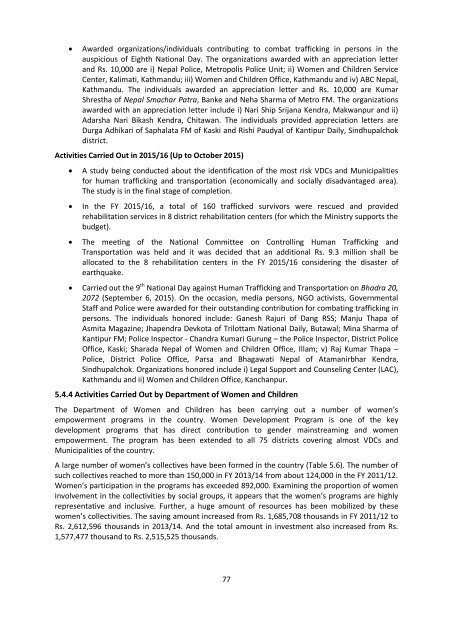TRAFFICKING IN PERSONS
397604438Trafficking_in_Persons_National_Report_2013-15
397604438Trafficking_in_Persons_National_Report_2013-15
Create successful ePaper yourself
Turn your PDF publications into a flip-book with our unique Google optimized e-Paper software.
The scholarships are primarily provided to disadvantaged communities, vulnerable groups and those<br />
residing in remote areas (Table 5.7).<br />
Table 5.7 Number of students provided scholarship<br />
Types of scholarship 2010/11 2011/12 2012/13 2013/14 2014/15*<br />
Girls studying in grade 1-8 grade 2,293,744 2,276,479 1,907,469 1,686,480 1,045,684<br />
Handicapped students (1-8) 62,163 69,944 59,098 53,903 13,399<br />
Handicapped students (9-10) 4,494 6,193 4,841 4,055 788<br />
Specially Targeted groups (23 ethnic) 1-8 104,157 86,712 106,517 77,900 27,677<br />
grade<br />
Dalit (1-8) 1,100,349 1,200,816 1,000,741 870,888 531,581<br />
Dalit (9-10) - 75,511 79,587 75,386 39,755<br />
Scholarship for Martyr’s Children 37 62 89 99 12<br />
Kamlari (scholarship and capacity<br />
7,673 7,886 6,882 7,655 3,479<br />
development)<br />
Remote scholarship (mountain hostels) 413 407 437 480 428<br />
Feeder hostel scholarship 400 400 399 391 330<br />
Conflict victims scholarship 3,808 8,097 7,412 6,846 523<br />
For model hospitals 148 222 382 307 356<br />
For boarding school students in mountains 220 140 160 180 128<br />
Secondary education scholarship 58,836 59,023 58,412 55,826 37,270<br />
Scholarship for endangered ethnic people 13,595 32,703 9,252 8,552 1,100<br />
Scholarship for target groups of science in<br />
Higher Secondary level<br />
80 76 68 39 -<br />
Note: * of first, eight months.<br />
Source: Ministry of Finance, 2015.<br />
Food for Education Program has been in operation in 10 districts - Dailekh, Rukum, Doti, Dadeldhura,<br />
Achham, Baitadi, Bajhang, Bajura, Darchula and Jajarkot. The program aims to improve the nutrition<br />
and health condition of students and thereby contributing to raise the daily attendance, reduce the<br />
class dropout rate, increase learning, result/capacity of children. Table 5.8 shows the number of<br />
students provided food for work program from FY 2011/12 to 2014/15.<br />
Table 5.8 Number of students provided food for work program<br />
Types of program 2011/12 2012/13 2013/14 2014/15*<br />
Day Snacks Program 132,000 151,701 141,423 156,000<br />
Girl Student Encouragement Program 40,197 50,180 - -<br />
Mother and Child Health Care Program 15,497 14,325 - -<br />
Note: * of first, eight months.<br />
Source: Ministry of Finance, 2015.<br />
Outcomes of Education - Data from the Department of Education (2012) indicated that there are<br />
more than 6.5 million children in basic level (1-8 grades) and more than 0.85 million in secondary<br />
level (9-10 grades) of education in Nepal recent years 11 . Gender gap in Basic Level of education<br />
ended by 2010 while it remained somewhat in secondary and higher secondary levels even after<br />
2011. However, gender gaps in Basic Level of education have not been ended across the social<br />
groups in Nepal. There is still gender gap in school enrolment among Dalit community –<br />
proportionally less number of girls against boys is enrolled in schools. On the other hand, there is<br />
gender equity in school enrolment among Janajati groups and even the number of girls, to some<br />
extent, exceeds boys in higher secondary level of education.<br />
11 The school education system consists of primary (1-5 grade), lower secondary (6-8 grade), secondary (9-10 grade) SLC and<br />
higher secondary (11-12 grade). Broadly, schools are categorized into: community schools (supported by government)<br />
and institutional schools (supported by parents and trustees).<br />
79


